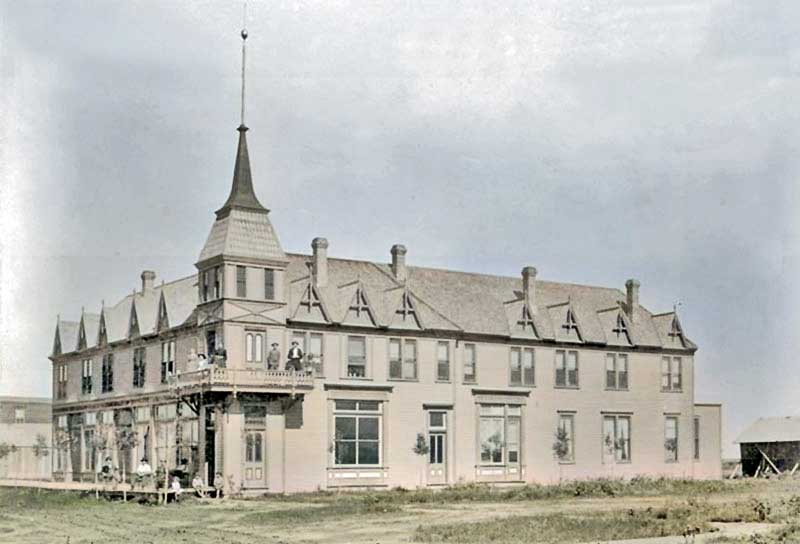
The Windsor Hotel in Springfield, Kansas in 1895.
Springfield, Kansas, was once a bustling town in Seward County that served as the temporary county seat. The town is gone today.
A town company was organized in the fall of 1885, a townsite was chartered on September 18, 1885, and was first called La Grand when a post office was established on December 31, 1885.
Platted the following spring, La Grand soon became a bustling town with a school, two hotels, and businesses around the public square. Many of its first residents moved here from Carthage, a town in Meade County that was abandoned in the spring of 1886.
Governor John Martin named Springfield the temporary county seat in June 1886. However, Fargo Springs sought the county seat, which set in motion what would eventually become a six-year county seat war.
Commissioners arranged an election that was held on August 5, 1886, to determine which town would be the county seat. The election board was in a closed-off room in a building in Fargo Springs, and the ballots were passed from the outside through a raised window. Because the Springfield folks didn’t like that method, a soapbox wagon was put in front of the voting place. They placed their ballots in the soap box, but the next day, those ballots were not counted when the county commissioners met to canvass the votes. Only the ballots cast through the window were deemed legal. Afterward, the government was moved to Fargo Springs. In the meantime, the citizens of La Grand took the case to the Kansas Supreme Court, and after ten months of litigation, the court declared that the “soapbox” ballots were the legal ones. The county seat was then returned to La Grand.
The first newspaper was the Springfield Transcript, established in 1886 by L.P. Kemper. County buildings were not built for several years, yet within a short time, significant bonded indebtedness had accumulated. The county scrip was handled extravagantly by the officials. In 1888, the state’s attorney general brought legal action against Oliver Leisure, the county clerk, and two commissioners, charging them with defrauding the county of several thousand dollars.
In 1887, the county commissioners purchased $100,000 in stock in the Kansas Southern Railroad, using bonds that had been voted to secure a railroad to the town. However, the railroad bypassed Springfield and built its tracks to Liberal. The result was a decline in the town’s businesses, and by 1893, the county seat had been moved to Liberal. No buildings from the town remain today.
The post office and town’s name was changed to Springfield on November 18, 1887.
Even though the county seat war appeared to end peacefully, bitterness remained in Springfield over the conflict and court decisions in Seward and its neighboring counties. On February 18, 1888, suits were filed in the Kansas Supreme Court against Seward County officials, alleging that they had engaged in fraudulent claims, received bribes, and robbed the county’s people.
In 1890, the county’s population was 1,503. That year, the county records were burned at Springfield, and the facts then came to public notice that the county had a bonded indebtedness of $100,000 with practically nothing to show for it.
Theodosius Botkin was a district judge who had been involved in many disputes in southwest Kansas. In Seward County, his rulings had been primarily in favor of Fargo Springs, which made some Springfield citizens so angry that they plotted to ambush and kill him in January 1892. However, one of the plotters told the undersheriff, H.P. Larrabee, a few hours before the plot was to be carried out in the early morning hours of January 3. Sheriff Samuel Dunn and six other men left Springfield the night before and walked to the Cimarron canyons, where they waited for the would-be assassins near where the plot was going to take place. When the men who had planned the assassination and interested bystanders came to the area several hours later, the sheriff told one group to disperse and leave. The rest of the sheriff’s group went to warn the judge, and they came upon the second group of troublemakers. When one of the sheriff’s men, Sid Nixon, turned and began to run after a period of shouting between the group and the sheriff’s men, the gang started firing. The men who were still talking to Sheriff Dunn heard the shooting and fired upon the sheriff, who was fatally wounded. No one was ever convicted of the murder of Sheriff Dunn.
In 1892, the last county seat election was held. The candidates were Liberal and Springfield. The former won by 125 votes. So confident were the Liberal adherents of a victory that a large number of farm wagons were drawn up before the county offices, and as soon as the vote was announced, the removal of the county property began. In less than three hours, it was all on the road to Liberal.
In 1910, Springfield was described as a rural post office of Seward County.
Springfield’s post office closed on February 15, 1913.
Springfield was located five miles northwest of the county’s center and three miles from the Cimarron River. It is 16 miles from Liberal, the county seat, and ten miles from Arkalon, the nearest shipping point.
©Kathy Alexander/Legends of America, October 2025.
Also See:
Sources:
Blackmar, Frank W.; Kansas: A Cyclopedia of State History, Vol I; Standard Publishing Company, Chicago, IL 1912.
Fort Hays State University
Historic Marker Database
